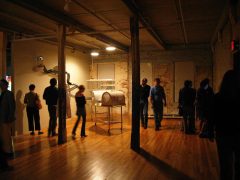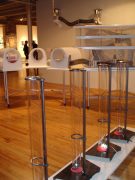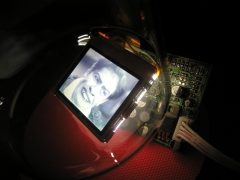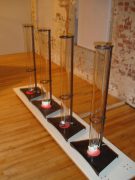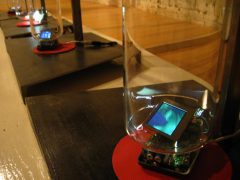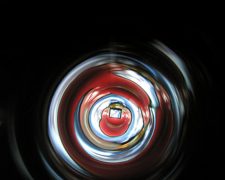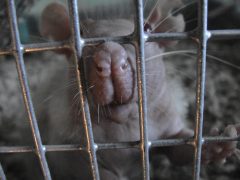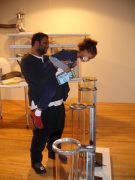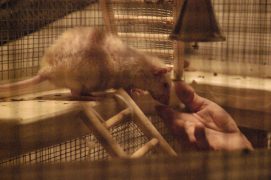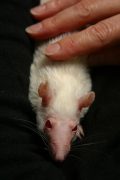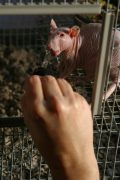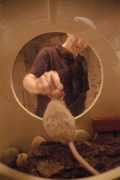Embracing Animal
2004-06
Site-specific, mixed media installation with glass tubes, video, sound, live transgenic laboratory rats in extended rat habitat, computer terminal with website.
What is our animal nature? Embracing Animal is a multi-media/ inter-species ersatz scientific installation of exchanges between people and animals.
In Embracing Animal, three transgenic lab rats, model HLA-B27, were given special housing and made available to the public’s view. Transgenic rats are microinjected with human DNA, allowing them to share our human genes. Transgenic rats are referred to as powerful ‘tools’ for the study of human health as they are, in many ways, physiologically close to humans. High was particularly interested in the rats that were used in autoimmune disease research for illnesses close to her own. But she treated her rats holistically, and as her sisters.
In an ersatz laboratory, a penthouse living quarters for the rats sits next to four large “tube-scopes,” 40” high glass sculptures for viewing films of human and non-human animal “becomings” – or animal/people transformations – becoming werewolves, vampires, exploring the shifting space between humans, monsters and beasts. The rat housing resembled a small city, with one section a tower for climbing, and one section a park. Daily a “lab technician” came to feed and check on the rats, perform the duties of care-taking.
This was a lab environment for observation, an experimental playground for people to feel the tension of exchanges, transitions, and trans-play. How do we identify and transform? What is our animal nature? This installation honored our kinship with our transgenic animal partners.
Credits: Rat housing designed by Kathy High and built by the fabrication team at MASS MoCA. Tube scopes construction design by Jack Naughton/Fab Inc. Transgenic rats provided by Taconic.
See the Embracing Animal website.
Embracing Animal
2004-06
What is our animal nature? Embracing Animal is a multi-media/ inter-species ersatz scientific installation of exchanges between people and animals.
In Embracing Animal, three transgenic lab rats, model HLA-B27, were given special housing and made available to the public’s view. Transgenic rats are microinjected with human DNA, allowing them to share our human genes. Transgenic rats are referred to as powerful ‘tools’ for the study of human health as they are, in many ways, physiologically close to humans. High was particularly interested in the rats that were used in autoimmune disease research for illnesses close to her own. But she treated her rats holistically, and as her sisters.
In an ersatz laboratory, a penthouse living quarters for the rats sits next to four large “tube-scopes,” 40” high glass sculptures for viewing films of human and non-human animal “becomings” – or animal/people transformations – becoming werewolves, vampires, exploring the shifting space between humans, monsters and beasts. The rat housing resembled a small city, with one section a tower for climbing, and one section a park. Daily a “lab technician” came to feed and check on the rats, perform the duties of care-taking.
This was a lab environment for observation, an experimental playground for people to feel the tension of exchanges, transitions, and trans-play. How do we identify and transform? What is our animal nature? This installation honored our kinship with our transgenic animal partners.
Credits: Rat housing designed by Kathy High and built by the fabrication team at MASS MoCA. Tube scopes construction design by Jack Naughton/Fab Inc. Transgenic rats provided by Taconic.
See the Embracing Animal website.












